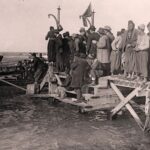הרבה מאוד הספיק מאוריצי גוטליב בחייו הקצרים, המלנכוליים, שאותם העביר בין משיכה לחברה הפולנית ולתרבות האירופית לבין רצון להשתמש במכחולו כפה נאמן לעמו. החן והפיוטיות שהצליח למצוא בחיי היומיום העלובים של הקהילה היהודית הפכו בידיו האמונות ליצירת מופת
אין ספק כי ציורו המפורסם ביותר של הצייר היהודי הפולני מאוריצי גוטליב (1856-1879), זה המזוהה עמו יותר מכל ציור אחר, הוא הציור 'יהודים מתפללים בבית הכנסת ביום הכיפורים' משנת 1878. לא די שזו היצירה שמייחסים לה את המספר הרב ביותר של רפרודוקציות והדפסים מבין יצירות האמנות היהודית המודרנית, נדמה שהאמן שיקע בתוכה במלאות ובעוצמה את תמציתם של הווייתו ושל סיפור חייו. בין המתכנסים לתפילה בבית הכנסת המסורתי ביום הקדוש ביותר בשנה הוא מיקם פעמים אחדות את דמותו שלו – כעלם עטוי טלית צבעונית הנראית זרה על רקע זמנו ומקומו, כנער השקוע במחזור התפילות, וגם כילד הלבוש במעיל צבעוני השייך לתקופה אחרת ושעל צווארו מדליון עם ראשי התיבות של שם הצייר – מ"ג. כנראה שבתמונה משולבות דמויות נוספות ממשפחתו, ובהן זו של אביו, ובין הנשים המתפללות מתנשאת דמותה של לאורה רוזנפלד – אהבתו הנכזבת של גוטליב, מי שהייתה מאורסת לו, הפרה את האירוסים ושברה את לבו. על מעיל ספר התורה שבידי אחד המתפללים מופיעה כתובת זיכרון שגוטליב תיאר בדיעבד כי רשם אותה כאילו יד נעלמה מכוונת את תנועותיו, וזו תרמה למסתורין האופף את התמונה: "נדבה לזיכרון נשמת המנוח כבוד מורנו הרב רבי משה גאטליעב זצ"ל, שנת תרל"ח לפ"ק [לפרט קטן]". דוק של עצב נסוך על פני הדמויות בבית הכנסת, ובעיקר על פניו של העומד במרכז התמונה – משה-מאוריצי גוטליב עצמו.
גורמים שונים הניעו את גוטליב לצייר יצירה מפורסמת זו, ועוד נשוב ונידרש לכך בהמשך, אך אפשר שבין השאר נמסך לתוך התמונה גם רגש אשמה ישן שליווה את האמן מאז אחד מימי הכיפורים שחווה בנעוריו. גוטליב, בן למשפחה מסורתית ושומרת מצוות, למד אז בגימנסיה פולנית, והנה רצה הגורל ודווקא ביום הכיפורים הקצו בבית ספרו זמן מיוחד לציור – מקצוע הלימודים היחיד, לצד לימודי ההיסטוריה, שהיה אהוב עליו, וכך הוטה לבו לקראת "חטאי הראשון, חטא מעורר חלחלה" (בתוך: עזרא מנדלסון, 'מאוריצי גוטליב – אמנות, היסטוריה, זיכרון', עמ' 30). לעיניהם המשתאות של מוריו וחבריו הנוצרים הגיע גוטליב לבית הספר בעיצומו של היום הקדוש והחל לצייר. הוא תיאר את שחש אחר כך:
שבתי הביתה כשאשמה עוכרת את מצפוני. כששאלוני היכן הייתי הציף סומק את לחיי ואחר כיסן חיוורון. עיניי מלאו דמעות. תשובה אחרת לא הייתה בפי (שם).
ייתכן אפוא ששנים מאוחר יותר מצא רגש אשמה זה את דרכו לתמונה המתארת את תפילת יום הכיפורים, תמונה שהייתה אולי שיא יצירתו האמנותית.

רגע מכונן
חייו הקצרים של גוטליב החלו בגליציה – אז חלק מהאימפריה האוסטרית שתהפוך עד מהרה לאוסטרו-הונגריה – בעיר הקטנה דרוהוביץ שכמחצית מתושביה היו יהודים. במחצית השנייה של המאה ה-19 השתפר מאוד מצבה הכלכלי של העיר בזכות תעשיית הנפט שהתפתחה בה. הוא נולד באזור שסבך של תרבויות, שפות וזיקות דתיות ולאומיות רחשו בו באותם ימים: נצרות קתולית לצד נצרות יוונית אורתודוקסית ויהדות מסורתית לצד יהדות חילונית; הלשונות פולנית, גרמנית ויידיש; לאומיות פולנית ולאומיות אוקראינית. גוטליב עצמו התעצב גם הוא כמי שזהויות שונות – תרבותיות ולאומיות – שוכנות בו זו לצד זו בערבוביה. על הזהות המפוצלת הזו ניתן ללמוד בין השאר ממגוון השמות שנשא בהזדמנויות שונות: משה היהודי, מוזס או מוריץ הגרמניים, ומעל כולם – מאוריצי הפולני.
משפחתו הייתה כאמור שומרת מצוות, אך היא השתייכה ל'מחנה השילוב' – קבוצה יהודית מודרנית ששאפה להשתלב בתרבות ובחברה הפולניות ונאחזה בגאווה במולדת הפולנית בד בבד עם שמירה על מורשתה היהודית. לפיכך, כשפנה הנער משה-מאוריצי עורף לקיום המצוות לא יצר הדבר קרע בינו לבין הוריו, אשר עשו כל שיכלו כדי להעניק לו חינוך מודרני שיאפשר את השתלבותו המלאה בחברה הסובבת. אין פלא אפוא שההורים – פאני ויצחק-איזק, סוחר בענף הטקסטיל שהפך ליזם בעסקי זיקוק הנפט – יכלו לזקוף לזכותם ארבעה בנים ציירים, בן משפטן ובת מורה ופסנתרנית חובבת. בת אחרת שלהם נישאה לצייר פולני לא יהודי, עובדה שוודאי שימחה אותם פחות. מכל מקום, כל ילדיהם מוכרים בשמות פולניים מובהקים.

את מסלולו החינוכי החל מאוריצי ב'חדר' המסורתי, שם רכש ידיעות בסיסיות בעברית וביהדות, ואחר כך עבר לבית ספר יסודי נוצרי, לגימנסיה פולנית שבה החל לחוש בעוצמה יחס אנטישמי מצד חבריו ללימודים, לגימנסיה גרמנית בלבוב וב-1872 החל את לימודיו באקדמיה לאמנות בווינה. על אף שמאוריצי עשה מאמצים מסוימים להשתלט כראוי על השפה הפולנית כדי להפוך פולני לכל דבר, כמו בבתים יהודיים רבים באוסטרו-הונגריה החינוך שקיבל בנעוריו כיוון אותו דווקא אל חיקה של התרבות הגרמנית. שפתו העיקרית הייתה אפוא הגרמנית, ורק אחריה באו הפולנית, העברית ואולי גם היידיש. ידיעותיו ביהדות התבססו על ניסיון החיים המועט שצבר בילדותו בבית מסורתי, ואת הצמא שגילה להיסטוריה היהודית הרווה באמצעות ספרים שקרא באופן עצמאי, בעיקר – כמו רבים מבני דורו – ספרו של ההיסטוריון היהודי היינריך (צבי) גרץ.
באקדמיה לאמנות של וינה נרשם גוטליב למחלקה לאמנות היסטורית – סוגה אמנותית מובילה באותם ימים שהעוסקים בה יצרו תמונות רבות רושם של אירועים היסטוריים אמיתיים וספרותיים. בבירה האוסטרית נפגש גוטליב עם אמנים מן השורה הראשונה, אך יותר מכל השפיע עליו כנראה המפגש עם תמונה שהוצגה בווינה ב-1873 – 'רייטן: מפלתה של פולין', פרי מכחולו של הצייר הפולני החשוב יאן מטייקו. הציור מתאר את הכינוס הדרמטי שנערך בוורשה ב-1773, ובו אישר הסיים הפולני את חלוקתה הראשונה של פולין. אירוע הרה אסון זה – מנקודת מבט פולנית – הביא תוך שנים ספורות לאיבוד עצמאותה של פולין ולחלוקתה בין אוסטריה, פרוסיה ורוסיה. בציור נראה ציר הסיים טדיאוש רייטן כשהוא שרוע על הרצפה ומוחה בתקיפות, אך ללא הועיל, נגד מנהיגיה של פולין המקבלים בתבוסתנות את ההסכם המביש, ובראשם המלך הכנוע וחסר האונים.
התמונה הדרמטית, הרומנטית והטרגית עשתה רושם בל יימחה על מאוריצי גוטליב הצעיר בעל הנפש הרגישה, ואפשר שכבר אז הבשילה בו ההכרה בדבר אחוות גורל המתקיימת בין שתי האומות המיוסרות, הפולנית והיהודית. מכל מקום, בנאום מאוחר יותר הוא העיד על עצמו כי הביט בתמונה כמהופנט ואז "ניצת בנשמתו זיק האמנות" (שם, עמ' 36). אז גם גמלה בלבו ההחלטה החריגה כל כך במסלול המקובל של צעירים יהודים כמותו – לעזוב את מרכז האימפריה האוסטרו-הונגרית ולחזור לשוליה, לגליציה, כדי ללמוד ציור בבית הספר לאמנות של קרקוב שנוהל על ידי יאן מטייקו עצמו.
אין לך מנוי לסגולה?
זו ההזמנות להצטרף למנוי בעברית או באנגלית ולקבל גישה לכל הכתבות באתר, את הגליון המודפס הביתה בדואר ועוד שלל הטבות מפתיעות
כבר מנויים? התחברו







